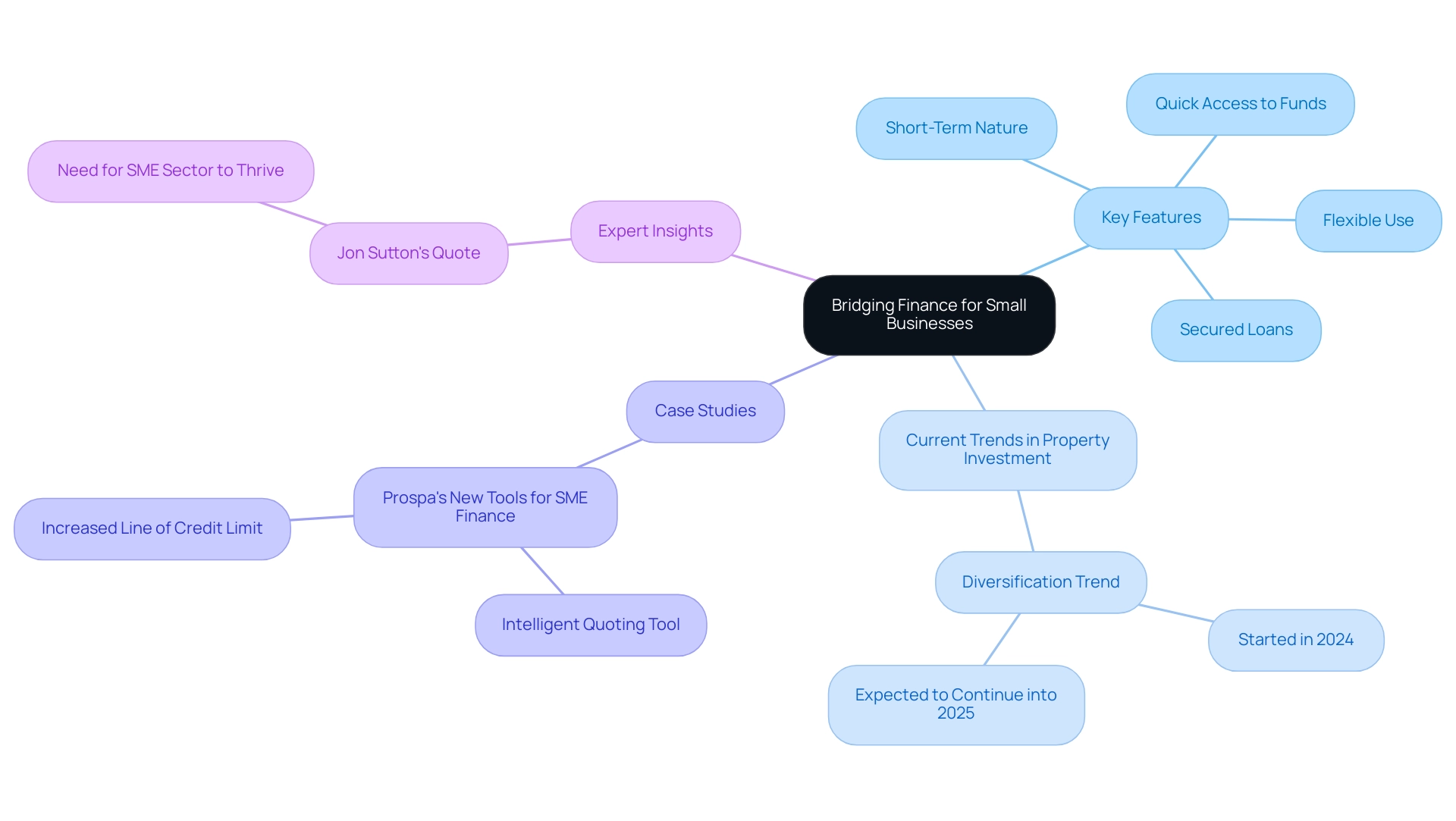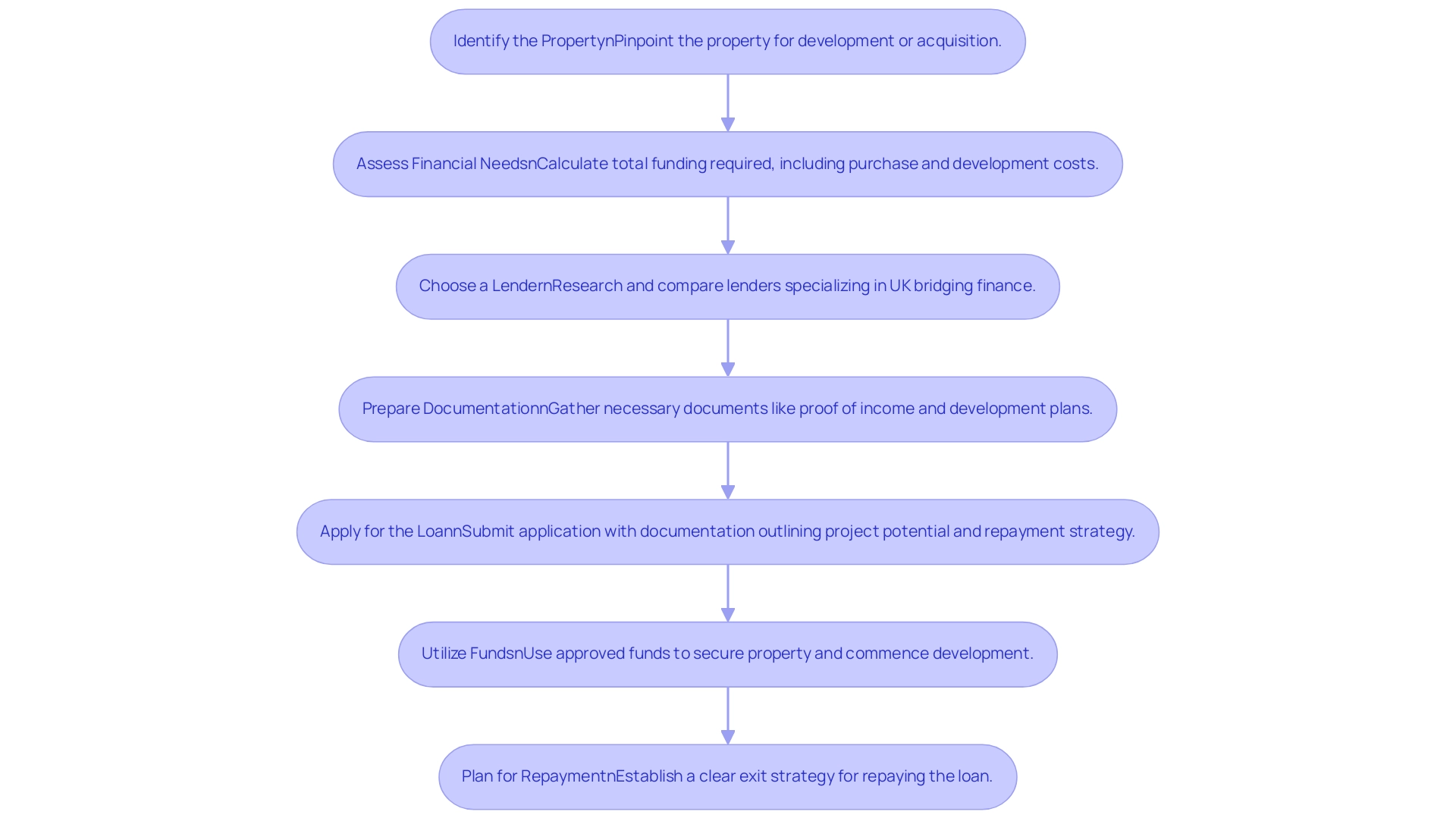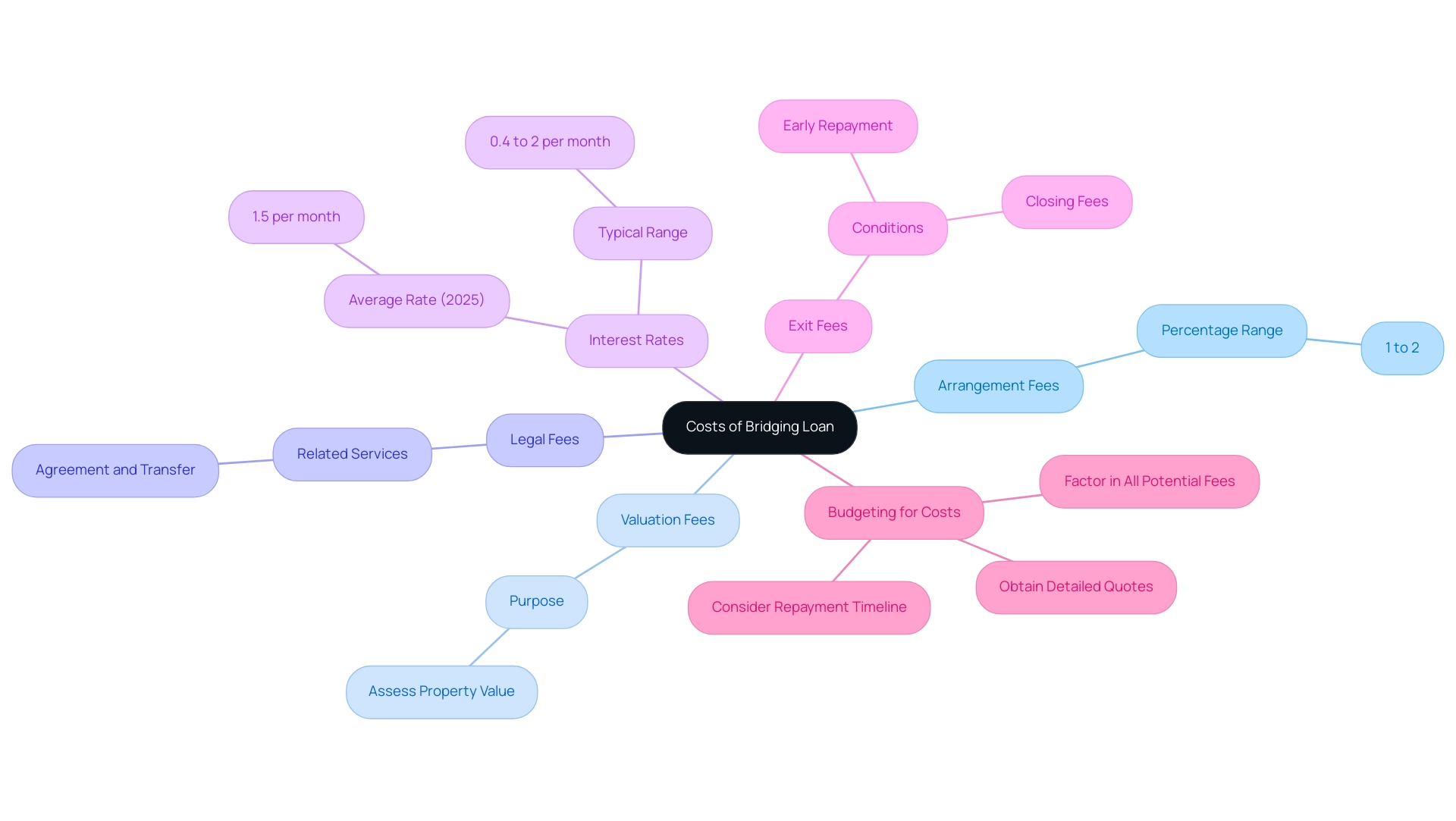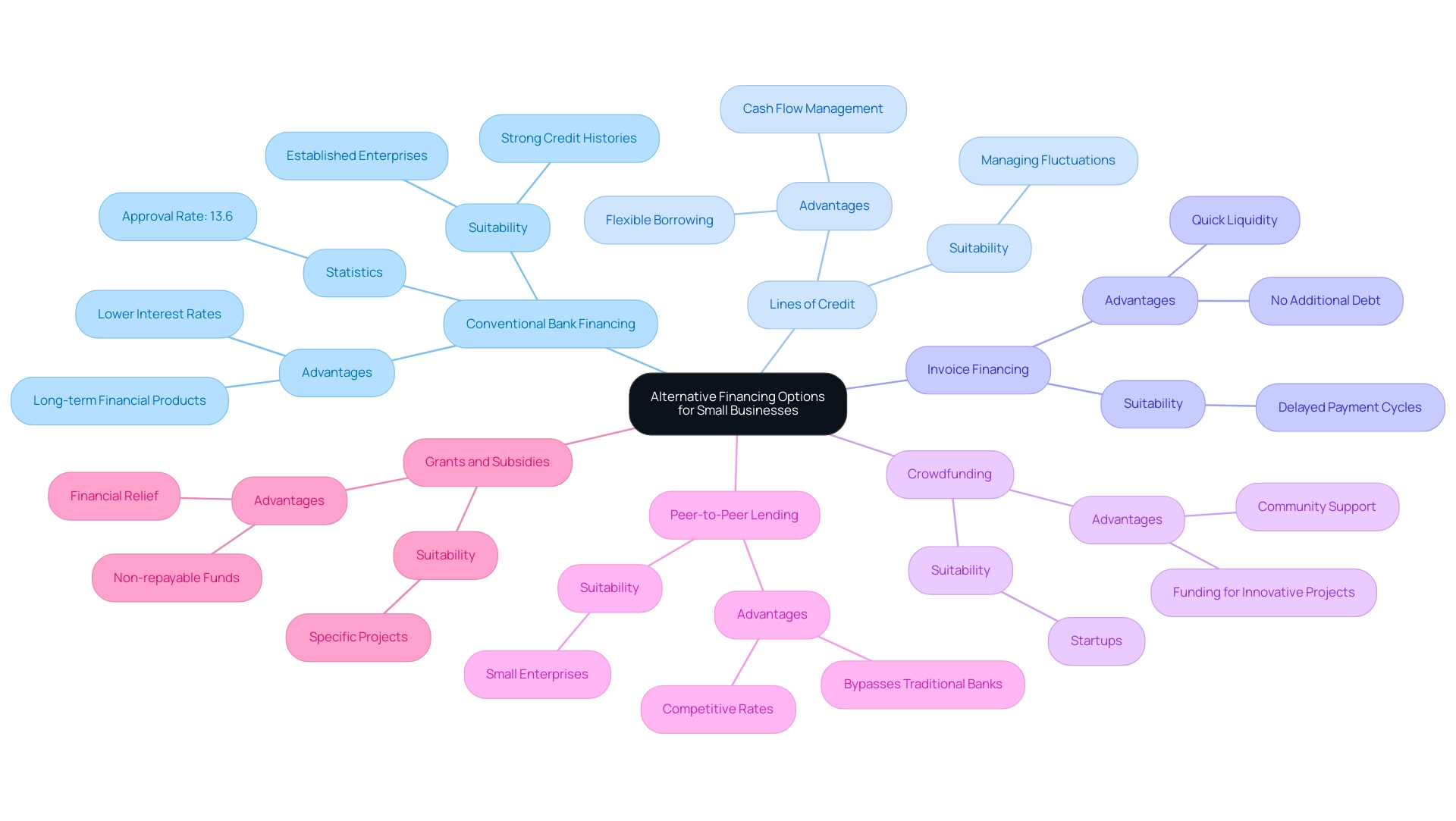Overview
Securing UK bridging finance is crucial for small business owners, offering a swift, short-term funding solution that effectively addresses immediate financial needs while aligning with long-term financing strategies. This article presents a systematic approach to obtaining these loans, emphasizing the necessity of understanding financial requirements. It outlines the importance of preparing thorough documentation and selecting appropriate lenders to guarantee quick access to funds for time-sensitive opportunities.
Furthermore, are you aware of the specific financial requirements your business needs to meet? Preparing the right documentation is essential, as it not only streamlines the application process but also increases your chances of approval. By choosing the right lender, you can ensure that your funding needs are met promptly, allowing you to seize opportunities as they arise.
In addition, consider the impact of timely financing on your business growth. A well-prepared approach to securing bridging finance can make a significant difference in your financial strategy. Take action now to explore your options and ensure your business is positioned for success.
Introduction
In the dynamic realm of small business finance, grasping the intricacies of bridging finance can significantly impact success. This short-term loan solution is tailored to swiftly meet immediate funding needs, particularly in real estate transactions, where timing is paramount. With the capability to secure funds within just a few days, small business owners can capitalize on time-sensitive opportunities that might otherwise be lost.
As they navigate transitional phases—such as acquiring new properties while waiting for existing ones to sell—understanding the nuances of bridging finance becomes vital. This article explores the key features, costs, and practical steps for effectively utilizing bridging loans, empowering entrepreneurs with the insights necessary to enhance their operational flexibility and financial stability in an ever-evolving economic landscape.
Understanding Bridging Finance: A Primer for Small Business Owners
UK bridging finance serves as a short-term loan specifically designed to bridge the gap between immediate funding needs and long-term financing solutions. This financial tool is particularly advantageous in real estate transactions, enabling enterprises to secure funds swiftly—often within just a few days—to seize time-sensitive opportunities. For small enterprise owners, understanding the complexities of financing is crucial, as it can provide the liquidity needed to handle cash flow during transitional phases, such as purchasing new property while awaiting the sale of a current one.
Typically, UK bridging finance is secured against property or other valuable assets, providing a flexible solution for enterprises in need of rapid capital access.
Key Features of Bridging Finance:
- Short-Term Nature: Bridging loans are generally repaid within a timeframe of 1 to 12 months, making them suitable for quick financial needs.
- Quick Access to Funds: Approval and funding can occur rapidly, often within a week, allowing organizations to act swiftly on opportunities.
- Secured Loans: These loans are usually secured against property or assets, which mitigates lender risk and can facilitate easier approval processes.
- Flexible Use: Funds from short-term financing can be utilized for a variety of purposes, including property purchases, renovations, or enterprise expansion.
The current environment for connecting finance for minor enterprises in 2025 shows a rising trend towards diversification in property investment, which began in 2024 and is anticipated to persist. This shift emphasizes the growing dependence on UK bridging finance as a feasible option for small enterprises navigating the complexities of real estate transactions. Recent statistics indicate that funds can often be accessed in as little as five working days upon receipt of all necessary information, underscoring the efficiency of this financing method.
Moreover, case studies illustrate the successful application of gap funding in real estate transactions. For example, minor enterprise owners have utilized UK bridging finance to acquire properties swiftly, enabling them to take advantage of advantageous market conditions without the holdups linked to conventional financing approaches. In response to the financial challenges faced by SMEs, Finance Story has introduced tailored funding solutions to assist brokers in providing finance quickly, including an intelligent quoting tool and an increased line of credit limit.
These innovations aim to enhance the efficiency of financing options available to SMEs, helping them navigate current economic pressures.
As Jon Sutton, CEO of non-bank ScotPac, emphasizes, "We really need the SME sector to be firing on all cylinders." This statement underscores the essential requirement for effective funding solutions in empowering minor enterprises. As the market develops, expert viewpoints highlight the significance of financing in enabling minor enterprises to stay adaptable and responsive to shifting economic conditions.
By grasping the advantages and main characteristics of gap finance, minor enterprise owners can make knowledgeable choices that improve their operational adaptability and financial security.

How Small Business Owners Can Utilize Bridging Loans for Property Development
UK bridging finance offers substantial benefits for small enterprise owners involved in property development. Here’s a structured approach to effectively utilize these financial tools:
Steps to Utilize Bridging Loans for Property Development:
- Identify the Property: Start by pinpointing the property you intend to develop or acquire. This initial step is crucial as it sets the foundation for your financing needs.
- Assess Financial Needs: Calculate the total funding required, including the purchase price and any immediate development costs. Understanding your financial landscape is essential for a successful application.
- Choose a Lender: Research lenders who specialize in UK bridging finance. Compare their terms, interest rates, and flexibility to find the best fit for your project. Finance Story, known for its professionalism and deep understanding of the finance sector, specializes in creating polished and highly individualized business cases to present to banks, making it a valuable partner in this process. With access to a full range of lenders, including high street banks and innovative private lending panels, Finance Story can help you find the right financing solution.
- Prepare Documentation: Gather all necessary documents, such as proof of income, detailed property information, and a comprehensive development plan. Well-prepared documentation can expedite the approval process and demonstrate your commitment to the project.
- Apply for the Loan: Submit your application along with the required documentation. Ensure that your application clearly outlines your project’s potential and your repayment strategy, as understanding repayment criteria is critical for securing financing.
- Utilize Funds: Upon approval, use the funds to secure the property and commence development. UK bridging finance options are designed for rapid access to capital, enabling you to act swiftly in competitive markets.
- Plan for Repayment: Establish a clear exit strategy, such as selling the developed property or refinancing into a long-term mortgage. This foresight is essential to guarantee you can repay the temporary financing without financial strain.
Short-term finance can be a game-changer, providing the necessary liquidity to navigate the complexities of the market. Successful property development projects that utilize UK bridging finance have shown that with the right planning and execution, small business owners can reach their financial objectives efficiently and effectively. Tim Coy, a research manager at Deloitte’s Center for Financial Services, emphasizes that the next generation of real estate talent will likely possess the tools to transform how this industry has traditionally operated, highlighting the significance of innovative financing alternatives.
Additionally, Finance Story's specialized expertise in navigating challenging financial situations, particularly with expat funding, further enhances its ability to assist clients effectively.

The Step-by-Step Process of Securing a Bridging Loan
Obtaining a temporary financial arrangement involves several crucial steps that can greatly influence your success. This guide will help you navigate the process effectively:
Step-by-Step Process:
- Evaluate Your Needs: Begin by determining the exact amount you require and the specific purpose of the funding. Understanding your financial needs is essential for making informed decisions.
- Research Lenders: Investigate various lenders specializing in bridging finance. Compare their rates, terms, and customer reviews to identify the best fit for your situation. Digital innovation and Open Banking have enhanced access to finance, simplifying the evaluation of options.
- Prepare Your Application: Gather all necessary documentation, which typically includes:
- Proof of income
- Details of the property being used as collateral
- A clear exit strategy for repayment, outlining how you plan to pay back the loan. Here, the expertise of Finance Story is invaluable, as we specialize in creating polished and highly individualized cases to present to lenders, ensuring your application stands out.
- Submit Your Application: Complete the application form thoroughly and submit it along with your documentation. Ensure that all information is accurate to avoid delays.
- Await Approval: After submission, the lender will assess your application. This process may involve a valuation of the property to determine its worth and suitability as collateral. Approval times can vary; however, alternative lenders often provide decisions within hours, compared to traditional banks that may take weeks. This rapid response time is crucial for enterprises needing immediate capital.
- Receive Funds: Once approved, the funds will be released, typically within five business days, allowing you to proceed with your plans without unnecessary delays.
- Repay the Loan: It’s essential to have a solid repayment plan in place. Ensure you understand the terms and are prepared to repay the amount within the agreed timeframe to avoid any penalties. Understanding repayment criteria is vital for maintaining a healthy financial standing.
Key Requirements for Applying for a Bridging Loan:
- A clear purpose for the loan
- Sufficient collateral
- A well-defined exit strategy
- Strong financial documentation
- Good communication with lenders
- Planning for future growth
Expert Insights: Financial advisors emphasize the importance of knowing your financial numbers—revenue, expenses, and profit margins—before applying for a bridging loan. As one CEO noted, "Know Your Numbers: Revenue, expenses, profit margins — have them at your fingertips." This knowledge not only strengthens your application but also enhances your negotiating power with lenders, a principle that Finance Story embodies in its financing solutions.
Case Studies: Consider the experiences of small business owners who successfully secured bridging loans. Many found that by leveraging alternative lenders, they could access funds quickly, enabling them to seize immediate opportunities that traditional banks would have delayed. This rapid response time is crucial for enterprises needing immediate capital.
By adhering to these steps and grasping the requirements, small enterprises can significantly improve their chances of obtaining a temporary financial arrangement successfully in 2025. Additionally, Finance Story offers a full range of lenders to suit various circumstances, whether you are looking to finance a warehouse, retail premise, factory, or hospitality venture. We also provide refinancing options to meet the evolving needs of your business.

Understanding the Costs: What to Expect When Applying for a Bridging Loan
When seeking UK bridging finance, understanding the associated costs is crucial for effective financial planning. Here’s a detailed overview of what to expect:
Common Costs Involved:
- Arrangement Fees: Typically ranging from 1% to 2% of the borrowed amount, these fees are charged by lenders for processing the application and facilitating the borrowing process.
- Valuation Fees: These costs are incurred for assessing the value of the property being used as collateral, ensuring that the lender has a clear understanding of the asset's worth.
- Legal Fees: Legal services related to the agreement and property transfer can add to the overall costs, making it essential to account for these expenses in your budget.
- Interest Rates: Bridging financing generally carries higher interest rates compared to traditional options, often falling between 0.4% and 2% per month. This variance can significantly affect the total cost of borrowing, particularly for extended terms. As of 2025, the average interest rate for temporary financing is approximately 1.5% per month, which small enterprise owners should factor into their financial planning.
- Exit Fees: Some lenders impose fees for early repayment or for closing the financing, which can affect the overall financial strategy.
Budgeting for Costs:
To effectively budget for these costs, small enterprise owners should consider the following steps:
- Obtain Detailed Quotes: Request comprehensive quotes from multiple lenders to understand the full scope of potential fees and interest rates. Finance Story focuses on developing refined and highly personalized business cases to present to lenders, ensuring that you obtain the best possible conditions for your financing. We work with a full range of lenders, including high street banks and innovative private lending panels, to suit your specific circumstances.
- Factor in All Potential Fees: When calculating the total cost of borrowing, ensure that all associated fees are included to avoid unexpected expenses.
- Consider the Timeline for Repayment: A well-planned repayment timeline can help minimize interest costs, making it vital to align your financial strategy with your cash flow capabilities. Furthermore, it is crucial for borrowers to verify with lenders that they will have sufficient time to sell their home before the financing term concludes. Understanding these expenses is vital for making informed choices about UK bridging finance options. For example, a recent case study showcased a client who obtained a £1.5 million financial support for a £2.3 million self-build project within a tight timeframe. This successful financing not only facilitated the project but also underscored the importance of budgeting for all associated costs to ensure timely completion. This case exemplifies how working with Finance Story can provide tailored solutions that meet your financing needs. By being proactive and informed, entrepreneurs can navigate the complexities of gap financing and secure the funding they require efficiently, leveraging the expertise of Finance Story to customize their financial solutions.

Exploring Alternative Financing Options for Small Business Owners
While bridging financing presents a viable funding solution, small enterprise owners should explore a variety of alternative funding options that cater to their specific needs. Here are some noteworthy alternatives:
- Conventional Bank Financing: These long-term financial products typically offer lower interest rates and are best suited for established enterprises with strong credit histories. However, securing approval can be quite challenging, as highlighted by a mere 13.6% approval rate for loan requests to larger banks in 2021. This statistic underscores the hurdles small enterprise owners encounter when seeking financing through traditional channels.
- Lines of Credit: This flexible borrowing option allows companies to withdraw funds as needed, making it ideal for managing cash flow fluctuations. It serves as a safety net for unexpected expenses or opportunities.
- Invoice Financing: This method enables companies to access funds based on outstanding invoices, providing quick liquidity without incurring additional debt. It is particularly advantageous for companies experiencing delayed payment cycles.
- Crowdfunding: By raising small amounts of money from a large number of individuals, often via online platforms, organizations can finance innovative projects or startups. This approach not only secures funding but also cultivates a community of supporters.
- Peer-to-Peer Lending: This option allows companies to borrow directly from individual investors through online platforms, often at competitive rates. It bypasses traditional banking obstacles, offering a more accessible route to funding.
- Grants and Subsidies: Non-repayable funds from governments or organizations can significantly support specific projects or activities, providing financial relief without the burden of repayment.
In 2025, a substantial proportion of independent enterprises are expected to utilize alternative financing methods, reflecting a shift towards more accessible and flexible funding solutions. For instance, alternative lenders boast a higher approval rate of 24.5%, while credit unions offer a 20.5% approval rate, showcasing the effectiveness of these options compared to conventional bank financing.
As independent enterprise owners navigate their financing options, understanding the landscape of conventional bank loans versus UK bridging finance is crucial. UK bridging finance often facilitates quicker access to funds, which can be essential for time-sensitive opportunities. According to Mike Berner, a Senior Analyst, "Beyond dedicating himself to exploring and evaluating the latest financial solutions, organizations can leverage artificial intelligence tools to enhance their financing strategies."
By considering these alternatives and incorporating strategies such as diversifying revenue streams and applying for government grants, small business owners can equip themselves with a robust toolkit to support their growth and development needs.

Conclusion
Bridging finance stands out as a crucial tool for small business owners aiming for agility in their financial strategies, particularly within the dynamic landscape of real estate transactions. The defining characteristics of bridging loans—short-term nature, rapid access to funds, and flexible usage—enable entrepreneurs to capitalize on time-sensitive opportunities that can profoundly affect their operational success. By comprehensively understanding the costs associated with these loans, such as arrangement, valuation, and interest fees, business owners can strategically prepare and plan their financial commitments.
The outlined step-by-step process for securing a bridging loan underscores the necessity of meticulous preparation, from identifying the right property to formulating a robust repayment strategy. With a methodical approach, bridging finance can empower successful property development, enabling small businesses to adeptly navigate market complexities. Moreover, exploring alternative financing options expands the financial landscape, presenting diverse solutions tailored to specific business needs.
Ultimately, the capacity to leverage bridging finance, in conjunction with other funding avenues, equips small business owners with essential tools to bolster their financial stability and operational flexibility. By embracing innovative financing solutions, businesses can not only endure but flourish in an ever-evolving economic environment, ensuring they remain competitive and responsive to market demands.

